Juan Carlos Ruiz-Sicilia
Degrees of Freedom of Holographic MIMO -- Fundamental Theory and Analytical Methods
Apr 17, 2025Abstract:Holographic multiple-input multiple-output (MIMO) is envisioned as one of the most promising technology enablers for future sixth-generation (6G) networks. The use of electrically large holographic surface (HoloS) antennas has the potential to significantly boost the spatial multiplexing gain by increasing the number of degrees of freedom (DoF), even in line-of-sight (LoS) channels. In this context, the research community has shown a growing interest in characterizing the fundamental limits of this technology. In this paper, we compare the two analytical methods commonly utilized in the literature for this purpose: the cut-set integral and the self-adjoint operator. We provide a detailed description of both methods and discuss their advantages and limitations.
Spatial Multiplexing in Near-Field Line-of-Sight MIMO Communications: Paraxial and Non-Paraxial Deployments
Jun 27, 2024
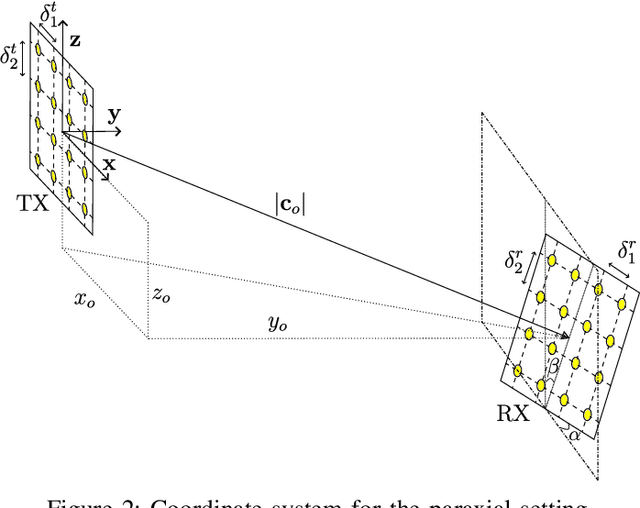
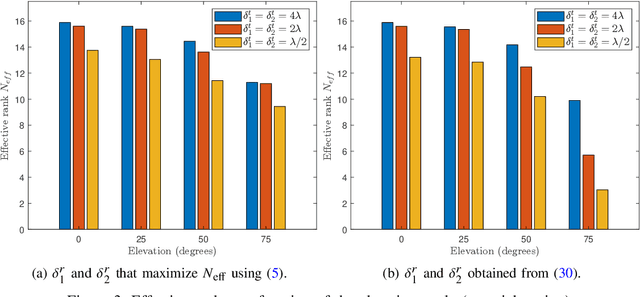

Abstract:Sixth generation (6G) wireless networks are envisioned to include aspects of energy footprint reduction (sustainability), besides those of network capacity and connectivity, at the design stage. This paradigm change requires radically new physical layer technologies. Notably, the integration of large-aperture arrays and the transmission over high frequency bands, such as the sub-terahertz spectrum, are two promising options. In many communication scenarios of practical interest, the use of large antenna arrays in the sub-terahertz frequency range often results in short-range transmission distances that are characterized by line-of-sight channels, in which pairs of transmitters and receivers are located in the (radiating) near field of one another. These features make the traditional designs, based on the far-field approximation, for multiple-input multiple-output (MIMO) systems sub-optimal in terms of spatial multiplexing gains. To overcome these limitations, new designs for MIMO systems are required, which account for the spherical wavefront that characterizes the electromagnetic waves in the near field, in order to ensure the highest spatial multiplexing gain without increasing the power expenditure. In this paper, we introduce an analytical framework for optimizing the deployment of antenna arrays in line-of-sight channels, which can be applied to paraxial and non-paraxial network deployments. In the paraxial setting, we devise a simpler analytical framework, which, compared to those available in the literature, provides explicit information about the impact of key design parameters. In the non-paraxial setting, we introduce a novel analytical framework that allows us to identify a set of sufficient conditions to be fulfilled for achieving the highest spatial multiplexing gain. The proposed designs are validated with numerical simulations.
On the Degrees of Freedom and Eigenfunctions of Line-of-Sight Holographic MIMO Communications
Aug 15, 2023Abstract:We consider a line-of-sight communication link between two holographic surfaces (HoloSs). We provide a closed-form expression for the number of effective degrees of freedom (eDoF), i.e., the number of orthogonal communication modes that can be established between the HoloSs. The framework can be applied to general network deployments beyond the widely studied paraxial setting. This is obtained by utilizing a quartic approximation for the wavefront of the electromagnetic waves, and by proving that the number of eDoF corresponds to an instance of Landau's eigenvalue problem applied to a bandlimited kernel determined by the quartic approximation of the wavefront. The proposed approach overcomes the limitations of the widely utilized parabolic approximation for the wavefront, which provides inaccurate estimates in non-paraxial deployments. We specialize the framework to typical network deployments, and provide analytical expressions for the optimal, according to Kolmogorov's $N$-width criterion, basis functions (communication waveforms) for optimal data encoding and decoding. With the aid of numerical analysis, we validate the accuracy of the closed-form expressions for the number of eDoF and waveforms.
Low Complexity Optimization for Line-of-Sight RIS-Aided Holographic Communications
Apr 21, 2023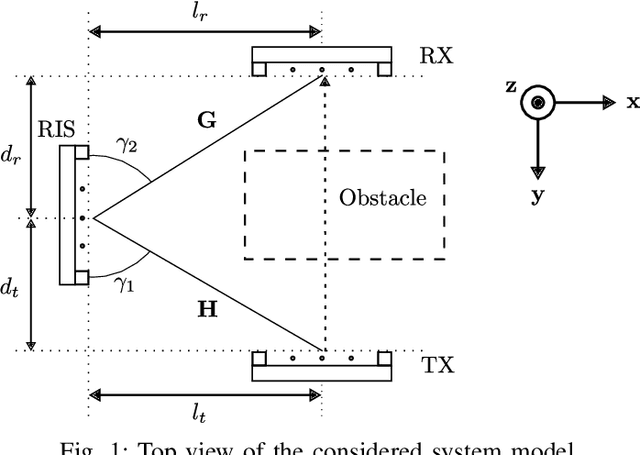
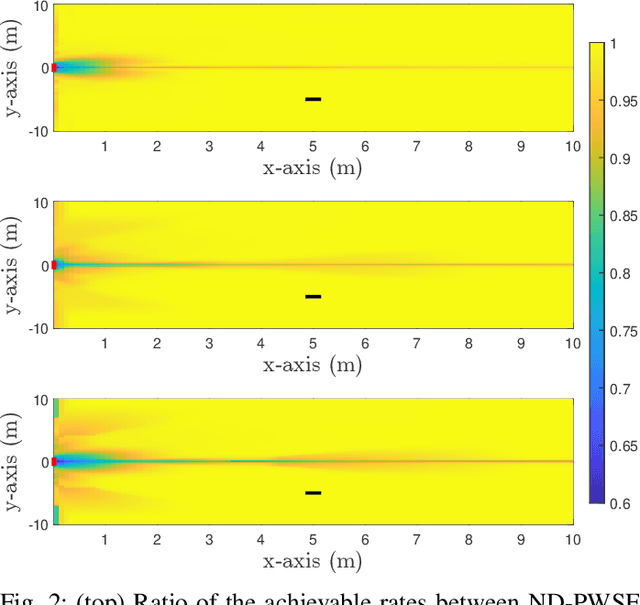
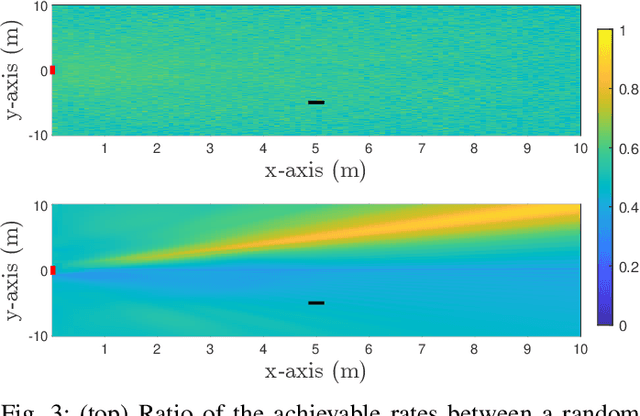
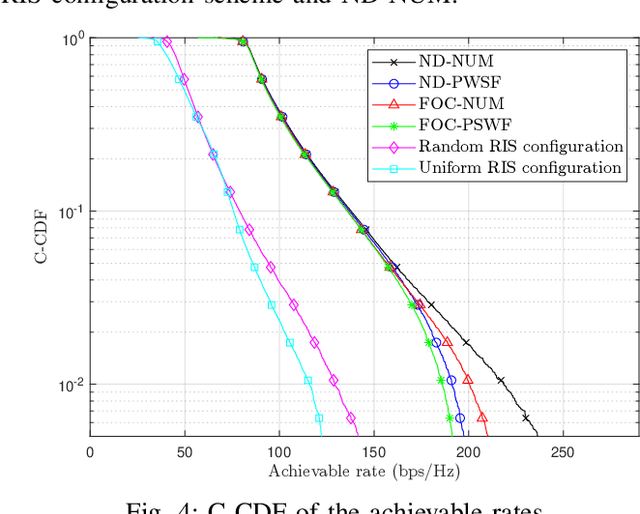
Abstract:The synergy of metasurface-based holographic surfaces (HoloS) and reconfigurable intelligent surfaces (RIS) is considered a key aspect for future communication networks. However, the optimization of dynamic metasurfaces requires the use of numerical algorithms, for example, based on the singular value decomposition (SVD) and gradient descent methods, which are usually computationally intensive, especially when the number of elements is large. In this paper, we analyze low complexity designs for RIS-aided HoloS communication systems, in which the configurations of the HoloS transmitter and the RIS are given in a closed-form expression. We consider implementations based on diagonal and non-diagonal RISs. Over line-of-sight channels, we show that the proposed schemes provide performance that is close to that offered by complex numerical methods.
On the Degrees of Freedom of RIS-Aided Holographic MIMO Systems
Jan 19, 2023Abstract:In this paper, we study surface-based communication systems based on different levels of channel state information for system optimization. We analyze the system performance in terms of rate and degrees of freedom (DoF). We show that the deployment of a reconfigurable intelligent surface (RIS) results in increasing the number of DoF, by extending the near-field region. Over Rician fading channels, we show that an RIS can be efficiently optimized only based on the positions of the transmitting and receiving surfaces, while providing good performance if the Rician fading factor is not too small.
 Add to Chrome
Add to Chrome Add to Firefox
Add to Firefox Add to Edge
Add to Edge